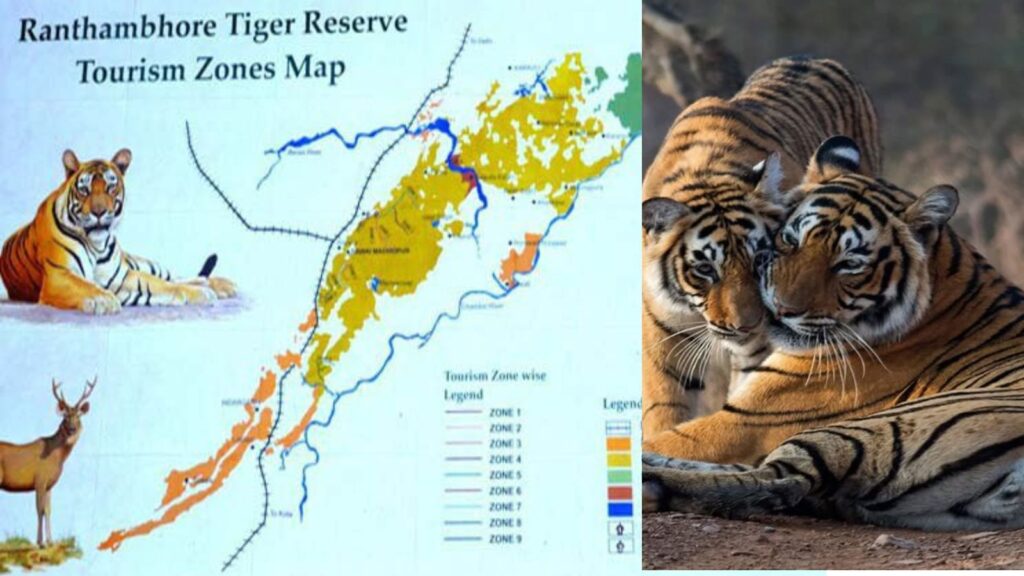Ultimate Guide to Tiger Sightings: Exploring Ranthambore’s Safari Zones 1-10

Ultimate Guide to Tiger Sightings: Exploring Ranthambore's Safari Zones 1-10
Zones 1-5 provide the best chances for tiger sightings, Zones 6-10 also present ample opportunities for observing these magnificent creatures.
Ranthambore National Park is divided into 10 safari zones, numbered from 1 to 10. Originally, the park comprised only 5 zones, but as its popularity increased, an additional 5 zones were introduced.
Zone 1
Access to this area is through Singh Dwar, serving primarily as a buffer zone that hosts T-39 and T-57. This zone gained significant attention with the return of Noor (T-39) and her three cubs, leading to numerous sightings reported towards the end of 2016 and the beginning of 2017.
Notable locations for spotting big cats in this zone include Tuti ka Nalla, Amreshwar Dang, Sultanpur, Peela Pani, and Gada Dub.
Zone 2
Recognized as one of the most vital areas, this zone has a high frequency of sightings. The presence of water holes attracts various cats, including T19, T22, T72, T57, T28, T60, and T39. Key locations for sightings in this zone are Jogi Mahal, Phuta Kot, Phuta Bandha, Lahpur Tiraha, and Nal Ghati. Leopard sightings have also been reported here.
Zone 3
Key sighting locations in this zone include Jogi Mahal, Padam Talab, High Point, Raj Bagh, and Mandook. Padam Talab is particularly noted as a prime vantage point for observing big cat activity, with T-19 and T-28 frequently spotted in this area.
Zone 4
This zone features numerous spots where elusive cats may emerge. It was once home to the renowned tigress of Ranthambore, Machli. Other notable cats in this area include T-28, T-64, T-19, T-75, T-41, and T-25. Important sighting locations include Singh Dwar, Malik Talab, Lakkad Da, Adidaant, Lambi, Tamakhan, and Berda.
Zone 5
The entry point for this zone is the same as Zone 4, sharing several common sighting locations. Key points include Singhdwar, Anatpur, Jokha, Dhakda, Kachida, Baghda, and Bakola. The big cats observed in this zone comprise T-25, T-28, T-17, T-74, and T-75.
Zone 6
This area shares its borders with Zone 1, presenting a favorable opportunity to observe T-39 (Noor) along with her cubs. The terrain here is notably distinct from Zones 1 to 5.
Visitors may encounter the Indian gazelle and have the chance to observe various bird species, including the endangered Red-headed Vultures. Notable locations for tiger sightings in this zone include Kala Pani, Saran Ka Pattha, Patwa Ki Baori, Khabli, and Soleshwar. Other tigers that have been sighted in this area are T-34, T-39, T-57, and T-8.
Zone 7
This zone has fewer sighting locations compared to others, with big cats observed at Chidikho, Jamoda, Kushalipura, and Rajbagh Naka. Both T-8 and T-34 have been recorded in this area.
Zone 8
The tigers found in this zone are the same as those in Zone 7, specifically T-8 and T-34. They have been sighted at locations such as Balas, Kherai, Kali, Neemli Dang, Bhat, and Mahakho.
Zone 9
Located approximately 45 minutes from the tiger reserve along the banks of the Chakal River, this zone is home to T-42 (Fateh), a notably aggressive male known for pursuing forest department vehicles and has been captured on camera while hunting a sloth bear. In addition to T-42, T-59 may also be spotted here. This zone also hosts Caracals, Sloth bears, and various aquatic birds.
Zone 10
In this zone, tigers can be observed at Aantri, Kushalipura, Bodal, Halonda, and Banskhori, alongside a variety of bird species. The tigers recorded in this area include T-13, T-42, and T-43.











